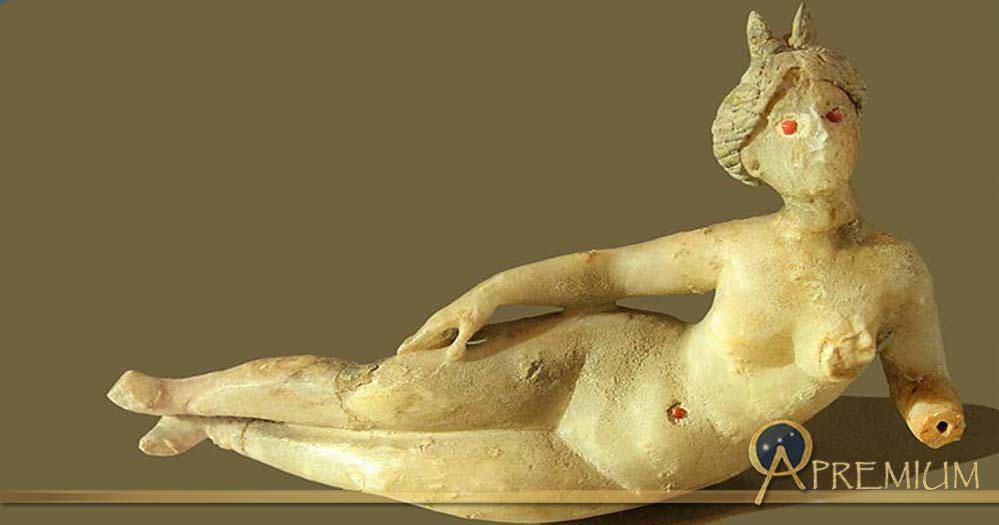Lost in Translation? Understandings and Misunderstandings about the Ancient Practice of “Sacred Prostitution”
In the modern world, the mere mention of “Sacred Prostitution” may receive raised eyebrows or disgusted grimaces. Evidently, this was also the case for the ancients as many ancient authors describe sacred prostitution in drastic terms. It was, according to the historian Herodotus, “the ugliest custom” of Babylon. The Greek geographer Strabo maintained that “virgin daughters,” even younger than 12 years of age, were dedicated to cult prostitution. The Old Testament mentions a specific category of people who are considered to have been the “professionals” of sacred prostitution in ancient Israel, with special rooms in the Jerusalem Temple, a state of affairs apparently accepted by the clergy in earlier times.

Statue of Herodotus (Wienwiki / Walter Maderbacher/CC BY-SA 3.0)
However, academics are now questioning these erotic stories. The strongly worded records regarding temple prostitution has been disputed by equally strong worded arguments. A fraction of researchers even disputes holy prostitution altogether, believing that it all began when a few ancient Greek writers concocted defamatory customs about foreigners as evidence of their moral inferiority. Some scholars, although still questioning some of the opinions of the past, insist that the phenomenon existed to a certain degree— believing that at there were temples in which even young girls held the highest offices of the priesthood and professional prostitutes who donated their own money to cult sites.
Understanding the Terms “Virgin” and “Harlot” as Used in the Ancient World
Before going any further, it is useful in this case to remember that throughout history, there were many ideas being translated from one language to another and a word in Akkadian, for example, would have at least a slightly different interpretation in Greek. Languages evolved overtime and the words we used in the present day would have had a different meaning in the ancient times. Examples of this are the words “virgin” and “harlot”. In the ancient world, the term “virgin” simply denoted an unmarried woman, or a woman who claimed legal ownership of herself instead of having her husband or a male member of her family as her guardian. This was a desirable state as proven in Rome, where some women would register themselves as prostitutes to have free rein of their own lives and money. As a consecrated virgin, women became free of many of the laws that would bind their freedom and assets to a husband or a male member of her family. The word did not mean possessing an intact hymen, like its definition today.
Ishtar was sometimes called the Goddess Har since she was the mother of the harlots. These “harlots” were not prostitutes as we know them, but priestesses and healers. These harlots were holy virgins serving goddesses such as Ishtar, Asherah, or Aphrodite.

The ancient Mesopotamian eight-pointed star symbol of the goddess Ishtar. (Public Domain)
The Hebrew word hor means “a cave” or “dark hole” and the Spanish word for “whore”, puta, derives from the Latin term for “a well”. In turn, the Latin term for “grave” is puticuli, which means “womb of rebirth”. The root of the word came from an early Sanskrit language where puta is defined as pure and holy. The cave, the hole and the bottomless black lake were metaphors for the Great Goddess— the primordial darkness from which all life is born. These terms were not derogatory. The separation into priestess and prostitute, or sacred and profane polarities, did not occur in western civilization until the early fathers of Christianity abolished goddess worship and other nature-based pagan religions. In fact, the concept of the whore and madonna was not constructed until 600 CE by the Papal Council.
This is a free preview of an exclusive article from Ancient Origins PREMIUM.
To enjoy the rest of this article please join us there. When you subscribe, you get immediate and full access to all Premium articles, free eBooks, webinars by expert guests, discounts for online stores, and much more!
- Pleasure, Procreation, and Punishment: Shocking Facts about Sex and Marriage in the Ancient World
- The Houses of Pleasure in Ancient Pompeii
- Roman Law and the Banning of ‘Passive’ Homosexuality
Top Image: Babylonian horned goddess statuette of alabaster, Louvre Museum. (Public Domain)



















Comments
I think the author understands that, however the fact that the bible would have to denounce such practices implies that they were common to the area and needed correction,
We learn in KINGS 15:12,
"He expelled the male shrine prostitutes from the land and got rid of all the idols his ancestors had made."
Referring to a time when prostitutes (male ones at that) were kept inside the temples of the Israelites.
An absolute falsehood, inferring the bible implies/states that temple prostitution was a part of the Israelite's religion. The law forbade a father encouraging his daughter to sell herself, and women who did were considered wanton and profane. The bible denounced clergy who desecrated the temple.
Very good article. This Western demarcation between woman as whore vs woman as madonna is at the centre of most social issues today and throughout history unfortunately.
- Moonsong
--------------------------------------------
A dreamer is one who can only find his way by moonlight, and his punishment is that he sees the dawn before the rest of the world ~ Oscar Wilde